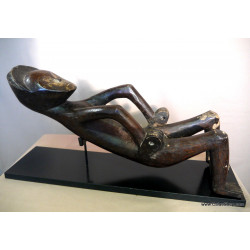M'Bolé hanged man statue
Mbolé artists are renowned for their anthropomorphic statues representing a hanged man...
-
 Secured payment
Secured payment
-
 Free shipping from 150 €
Free shipping from 150 €
-
 Guarantee "satisfied or refunded"
Guarantee "satisfied or refunded"
Exceptional: Superb and large wooden statue of a hanged man, typical of the M'Bolé ethnic group of the Democratic Republic of Congo
Length: 70 cm, delivered with its base
The M’bolé people
The one hundred and fifty thousand Mbolé live on the left bank of the Zaire River, in the heart of the Democratic Republic of Congo.
The Mbolé villages are autonomous, led by a chief elected from among the elders of each family. They live from the cultivation – by the women, while the men hunt – of cassava and rice.
Three societies structure the life of the Mbolé: the Ekanga, reserved for healers, the Otuku, for the wives of chiefs, and the Lilwa society, which controls most of the rites of social and religious life, from circumcision to death, through different initiation ceremonies. The chief of this society, known as isoya, plays such an important role in the life of the villagers that after his death, they bury him in a tree and keep his hut empty as a sign of respect.
Mbolé Masks and Statues
The Mbolé are best known for their ancestor statues characterized by geometric features, an elongated body, a large head with a heart-shaped face, a protruding mouth and a crown hairstyle. Yellow and white pigments are generally applied to these statues.
Mbolé masks are rare and worn only during circumcision ceremonies or for the funeral of a dignitary of the Lilwa society. Oval in shape, they are covered with pigments evoking a human face.
M’Bolé Hanged Man Statue
Mbolé artists are also known for their anthropomorphic statues, which have their hands on their hips, their legs slightly bent, their shoulders thrown forward and a large head with a heart-shaped face.
Usually medium-sized, they can reach a height/length of 100 cm.
It is generally believed that they represent a hanged man, called an ojika, judged guilty by the Lilwa society (see above) or sacrificed so that a dignitary could gain access to the rank of isoya of this society. These statues, sculpted by one of the family members of the hanged man – who was not entitled to a traditional funeral and was generally simply buried in the forest – are supposed to contain their soul. Kept in special huts in the forest, they are only displayed during initiation ceremonies to show the implications of a crime to new initiates. These statues are carried on stretchers (which explains why they do not stand upright, the bottom of their feet not being parallel to the body) and are the subject of various comments during meetings, even if women and children are not allowed to see them.
The statue presented here is typical of this style of statues; it also has a very beautiful brown patina.
Variants of the name Mbolé:
We can observe several variations in the name of the ethnic group: Bambole, Bole, Imona, Mboles








